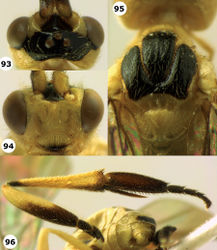| 1 | | | Maximum width of hind basitarsus 1.2–1.6 times apical width of hind tibia and dorsally convex (Figs 5, 28, 46, 64, 67, 71, 86); but sometimes weakly so (Figs 80, 83); if 1.2 times then hind basitarsus 3.8–6.0 times as wide as second hind tarsal segment (Figs 64, 67, 80, 83) | | | 2 |
| |
|
| – | | | Maximum width of hind basitarsus 0.8–1.1 times apical width of hind tibia and dorsally nearly straight (Figs 22, 52, 55, 58, 61, 77, 89, 92), but rarely slightly convex (Fig. 16); if 1.1 times then hind basitarsus 2.8–3.5 times as wide as second hind tarsal segment (Figs 40, 49, 74) | | | 11 |
| |
|
| 2 | | | Dorso-apically hind basitarsus strongly protruding, beyond apex of second tarsal segment (Fig. 71); scutellum distinctly convex; maxillary palp 0.7–0.8 times as long as height of head; [head weakly excavate medio-posteriorly in dorsal view; hind tibial spurs yellowish-brown]; Singapore, East and West Malaysia, Laos, *Vietnam | | | Hartemita singaporensis (Mao, 1945) |
| |
|
| – | | | Dorso-apically hind basitarsus weakly or not protruding, not surpassing middle of second tarsal segment (Figs 5, 28, 46, 64, 67, 86); scutellum slightly convex or flat; maxillary palp 1.0–1.5 times as long as height of head | | | 3 |
| |
|
| 3 | | | Ventral margin of clypeus curved medially (Figs 4, 23, 81, 84); hind basitarsus comparatively wide apically (Figs 5, 28, 83), but in Hartemita chinensis less so (Fig. 86) | | | 4 |
| |
|
| – | | | Ventral margin of clypeus more or less concave or straight medially (Figs 41, 62, 78); hind basitarsus comparatively wide apically (Figs 46, 64, 67, 80) | | | 8 |
| |
|
| 4 | | | Maxillary palp about 1.3 times as long as height of head; hind basitarsus 2.3–2.5 times as long as wide, 4.4–5.0 times as wide as second tarsal segment and 1.4–1.5 times as long as width of apex of hind tibia (Figs 5, 28, 83); propleuron entirely yellow; hind coxa with one black spot | | | 5 |
| |
|
| – | | | Maxillary palp about as long as height of head; hind basitarsus 2.8–3.0 times as long as wide, 3.6 times as wide as second tarsal segment and about 1.2 times as long as width of apex of hind tibia (Fig. 86); propleuron with a blackish spot posteriorly; hind coxa with two black spots; [mesosternum black; third hind tarsal segment of female 1.2–1.3 times longer than wide]; Oriental China | | | Hartemita chinensis Chen, He & Ma, 1998 |
| |
|
| 5 | | | Hind basitarsus about 2.3 times as long as remaining tarsal segments and 1.2 times as wide as apex of hind tibia (Fig. 83); third hind tarsal segment of female slightly longer than wide; mesosternum yellow; scutellar sulcus with 3 carinae; hind tarsal claws with 3–4 teeth; Oriental China | | | Hartemita flava Chen, He & Ma, 1998 |
| |
|
| – | | | Hind basitarsus about 1.8 times as long as remaining tarsal segments and 1.3–1.4 times as wide as apex of hind tibia (Figs 5, 28); third hind tarsal segment of female about twice as long as wide; mesosternum black; scutellar sulcus with 5–6 carinae; hind tarsal claws with 5–8 teeth | | | 6 |
| |
|
| 7 | | | Hind tarsal claws with 8 large teeth (Fig. 8); face finely punctate; hind basitarsus largely blackish (Fig. 5); temples parallel-sided (Fig. 7) and slightly punctate; Philippines, Japan | | | Hartemita muirii (Fullaway, 1919) |
| |
|
| – | | | Hind tarsal claws with 5 large teeth (Fig. 27); face rugose-punctate; hind basitarsus only apically blackish (Fig. 28); temples rather bulging (Fig. 23), roughly punctate dorsally and rugose-punctate ventrally; Vietnam | | | Hartemita khuatbaolinhae sp. n. |
| |
|
| 8 | | | Second-fourth hind tarsal segments slender, distinctly longer than wide (Fig. 64); dorsal side of hind basitarsus distinctly more curved than nearly straight ventral side and with a rather distinct apical prominence (Fig. 64); hind femur yellow; [posterior half of notauli widely crenulate; frons entirely smooth]; Oriental China, Nepal | | | Hartemita townesi Dangerfield & Austin, 1990 |
| |
|
| – | | | Second-fourth hind tarsal segments robust, slightly longer than wide (Figs 46, 67, 80); dorsal side of hind basitarsus similar to ventral side and truncate apically, without apical prominence (Figs 46, 67, 80); hind femur largely dark brown or black dorsally | | | 9 |
| |
|
| 9 | | | Hind basitarsus elliptical (Fig. 67); face distinctly punctate; mesopleuron below precoxal sulcus coarsely punctate; basal and apical quarter of hind tibia and largely spurs dark brown (Fig. 67); Brunei, *East Malaysia | | | Hartemita bruneiensis Dangerfield & Austin, 1990 |
| |
|
| – | | | Hind basitarsus nearly parallel-sided (Figs 46, 80); face punctulate or sparsely punctate; mesopleuron below precoxal sulcus rugulose-punctulate or smooth; hind tibia mainly and spurs yellowish-brown (Figs 46, 80) | | | 10 |
| |
|
| 10 | | | Head in dorsal view comparatively short and occiput weakly concave (Fig. 79); pronotum coarsely rugose-striate; POL 1.2–1.3 times diameter of posterior ocellus; dark part of hind basitarsus close to base of basitarsus (Fig. 80); mesopleuron below precoxal sulcus densely rugulose-punctulate; Japan, South Korea | | | Hartemita nigrotestacea Belokobylskij & Ku, 2001 |
| |
|
| – | | | Head in dorsal view comparatively long and occiput distinctly concave (Fig. 42); pronotum largely smooth except for median groove; POL 1.6 times diameter of posterior ocellus; dark part of hind basitarsus distinctly removed from base of basitarsus (Fig. 46); mesopleuron below precoxal sulcus smooth; Vietnam | | | Hartemita vietnamica sp. n. |
| |
|
| 11 | | | Ventral margin of clypeus more or less curved medio-ventrally (Figs 75, 90) and hind basitarsus 0.8 times wider than apex of hind tibia (Figs 77, 92) and 2.2–2.3 times wider than second hind tarsal segment | | | 12 |
| |
|
| – | | | Hind basitarsus 0.9–1.1 times wider than apex of hind tibia (Figs 16, 22, 40, 49, 52, 55, 58, 61, 74, 89) and 2.5–4.0 times wider than second hind tarsal segment, if rarely 0.8 times wider than apex of hind tibia then usually ventral margin of clypeus straight medio-ventrally or nearly so (Fig. 50) | | | 13 |
| |
|
| 12 | | | Hind basitarsus about 1.2 times as long as remaining tarsal segments (Fig. 92); hind basitarsus of male about 5 times as long as wide; face distinctly punctate; fourth hind tarsal segment of male distinctly longer than wide (Fig. 92; female unknown); [maxillary palp about as long as height of head]; Oriental China | | | Hartemita punctata Chen, He & Ma, 1998 |
| |
|
| – | | | Hind basitarsus about 1.5 times as long as remaining tarsal segments (Fig. 77); hind basitarsus of male about 4 times as long as wide; face faint transverse rugae; fourth hind tarsal segment of male slightly wider than long (Fig. 77; female unknown); India | | | Hartemita buteae Ahmad & Shujauddin, 2004 |
| |
|
| 13 | | | Hind basitarsus comparatively wide and its apical half largely yellowish (Fig. 16); hind basitarsus 4.0 times as wide as second hind tarsal segment (Fig. 16); occiput deeply concave (Fig. 13); [scutellar sulcus with 5–6 carinae; hind tarsal claws with 5–6 teeth]; Vietnam | | | Hartemita coffeana sp. n. |
| |
|
| – | | | Hind basitarsus comparatively narrow elliptical and its apical half more or less blackish or dark brown (Figs 22, 40, 49, 52, 58, 61, 74), but yellowish-brown in Hartemita basilaris (Fig. 55); hind basitarsus 2.8–3.3 times as wide as second hind tarsal segment (Figs 22, 40, 49, 52, 58, 61, 74, 89); occiput slightly to moderately concave (Figs 18, 36, 48, 51, 57, 60, 73), but deeply so in Hartemita excavata (Fig. 88) | | | 14 |
| |
|
| 14 | | | Ventral margin of clypeus weakly but evenly curved medially (Figs 53, 56, 59); temple largely smooth, but coarsely punctate in Hartemita basilaris; hind basitarsus distinctly narrowed apically (Figs 55, 58), but slightly so in Hartemita chapini (Fig. 61); length of body 6–9 mm, but in Hartemita chapini up to 5 mm | | | 15 |
| |
|
| – | | | Ventral margin of clypeus nearly straight to slightly concave medially (Figs 17, 35, 47, 50; 72, 87); temple more or less punctate; hind basitarsus slightly narrowed apically (Figs 22, 40, 49, 52, 74, 89); length of body 4.0–6.3 mm | | | 18 |
| |
|
| 15 | | | Head coarsely punctate (Fig. 53); hind basitarsus largely yellowish-brown; dorsal margin of clypeus evenly curved (Fig. 53); second-fifth hind tarsal segments less slender (Fig. 55); vein SR1 of fore wing almost vertical basally; [hind coxa with two black spots dorsally]; Indonesia, *East Malaysia | | | Hartemita basilaris Dangerfield & Austin, 1990 |
| |
|
| – | | | Head smooth or mainly finely punctate (Figs 56, 59); hind basitarsus largely dark brown or blackish; dorsal margin of clypeus straight or slightly sinuate (Figs 56, 59); second-fifth hind tarsal segments slender (Figs 58, 61); vein SR1 of fore wing distinctly oblique basally | | | 16 |
| |
|
| 16 | | | Outer side of hind tibia partly dark brown apically (Fig. 61); second submarginal cell of fore wing 3.3–4.0 times as long as wide near level of vein r; second-fifth hind tarsal segment less robust (Fig. 61); anterior transverse carina of propodeum absent; length of body 5.0–6.1 mm]; Philippines | | | Hartemita chapini (Mao, 1945) |
| |
|
| – | | | Outer side of hind tibia (except for dark brown basal ring) yellowish apically (Figs 96, 100); second submarginal cell of fore wing 3.6–4.6 times as long as wide near level of vein r; anterior transverse carina of propodeum more or less developed; length of body 6–9 mm | | | 17 |
| |
|
| 17 | | | Mesoscutum completely black near notauli (Fig. 95); OOL black (Fig. 93); ovipositor sheath dark brown; anterior transverse carina of propodeum moderately to weakly developed Indonesia, East and West Malaysia | | | Hartemita latipes Cameron, 1910 |
| |
|
| – | | | Mesoscutum brownish-yellow near notauli (Fig. 99); OOL yellow (Fig. 97); ovipositor sheath yellowish-brown; anterior transverse carina of propodeum coarsely developed; [apical rim of clypeus in Chinese specimens brownish-yellow]; Oriental China, Vietnam, Nepal | | | Hartemita maculata sp. n. |
| |
|
| 18 | | | Hind basitarsus 2.0–2.3 times as long as remainder of tarsus (Figs 49, 74); inner hind spur 0.5–0.6 times as long as hind basitarsus; maxillary palp about 1.3 times as long as height of head | | | 19 |
| |
|
| – | | | Hind basitarsus 1.4–1.8 times as long as remainder of tarsus (Figs 22, 40, 52, 89); inner hind spur 0.7 times as long as hind basitarsus; maxillary palp about as long as height of head or slightly shorter, but 1.3–1.4 times as long in Hartemita rhadinotarsa and Hartemita similis | | | 20 |
| |
|
| 19 | | | Clypeus concave medio-ventrally (Fig. 47); second submarginal cell of fore wing about 4 times as long as wide; medio-posteriorly mesoscutum with a wide depressed area; Philippines | | | Hartemita rudis (Mao, 1945) |
| |
|
| – | | | Clypeus truncate and protruding medio-ventrally (Fig. 72); second submarginal cell of fore wing 3.3–3.4 times as long as wide; mesoscutum medio-posteriorly without a wide depressed area; Far East Russia | | | Hartemita spasskensis Belokobylskij, 2005 |
| |
|
| 20 | | | Tarsal claws with 5–6 teeth; hind tibia yellow apically; [second and third metasomal tergites with black spots laterally; second submarginal cell of fore wing 3.0–3.3 times as long as wide]; Oriental China | | | Hartemita excavata Chen, He & Ma, 1998 |
| |
|
| – | | | Tarsal claws with 2–4 teeth (Figs 21, 39); hind tibia dark brown apically (Figs 22, 40, 52) | | | 21 |
| |
|
| 21 | | | Second and third metasomal tergites black laterally; vein 3-SR of fore wing 2.3–2.4 times as long as vein 2-SR and 0.7 times as long as vein SR1 (Fig. 37); Vietnam | | | Hartemita similis sp. n. |
| |
|
| – | | | Second and third tergites brownish-yellow laterally; vein 3-SR of fore wing 1.5–1.7 times as long as vein 2-SR and 0.5–0.6 times as long as vein SR1 (Fig. 19) | | | 22 |
| |
|
| 22 | | | Apical 0.3–0.4 of hind tibia dark brown or blackish (Fig. 52); vein 1-SR of fore wing gradually merging into vein 1-M; mesoscutum with 3 blackish patches; India, Nepal, Indonesia | | | Hartemita rhadinotarsa Dangerfield & Austin, 1990 |
| |
|
| – | | | Apical 0.2 of hind tibia dark brown or blackish (Fig. 22); vein 1-SR of fore wing angled with vein 1-M (Fig. 19); mesoscutum brownish-yellow, without blackish patches; Vietnam | | | Hartemita daklaka sp. n. |
| |
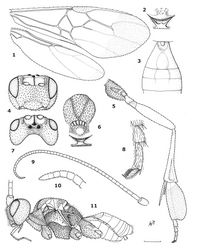
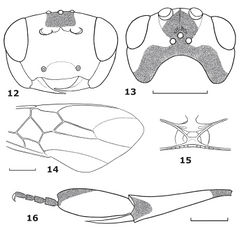
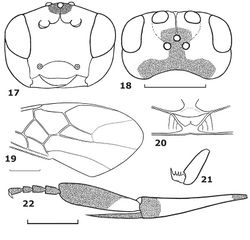


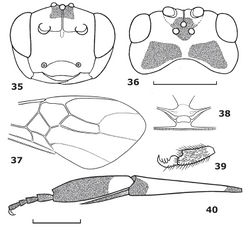
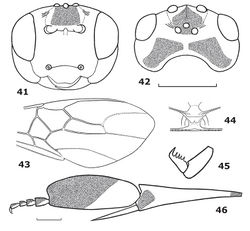
![Figures 47–55. 47–49 Hartemita rudis(Mao), female, holotype. 50–52. Hartemita rhadinotarsaDangerfield & Austin, female, paratype. 53–55. Hartemita basilarisDangerfield & Austin, female, holotype. 47, 50, 53 head frontal 48, 51, 54 head dorsal 49, 52, 55 hind tibia and tarsus lateral. After Dangerfield and Austin (1990)[1].](/w/media/thumb/b/b6/ZooKeys-102-019-g008.jpg/169px-ZooKeys-102-019-g008.jpg)
![Figures 56–64. 56–58. Hartemita maculata sp. n., female. 59–61. Hartemita chapiniDangerfield & Austin, female. 62–64. Hartemita basilarisDangerfield & Austin, female, holotype. 56, 59, 62 head frontal 57, 60, 63 head dorsal 58, 61, 64 hind tibia and tarsus lateral. After Dangerfield and Austin (1990)[1].](/w/media/thumb/d/de/ZooKeys-102-019-g009.jpg/169px-ZooKeys-102-019-g009.jpg)
![Figures 65–74. 65–67. Hartemita bruneiensisDangerfield & Austin, male, holotype. 68–71. Hartemita singaporensis (Mao), female. 72–74. Hartemita spasskensisBelokobylskij, female, holotype. 65 mesonotum and metanotum dorsal 68, 72 head frontal 66, 69, 73 head dorsal 67, 71, 74 hind tibia and tarsus lateral 70 hind tarsal claw. Figures 65–69, 71 after Dangerfield and Austin (1990)[1] and 72–74 after Belokobylskij (2005)[2]](/w/media/thumb/c/cf/ZooKeys-102-019-g010.jpg/178px-ZooKeys-102-019-g010.jpg)
![Figures 75–83. 75–77. Hartemita buteaeAhmad & Shujauddin, male, holotype. 78–80. Hartemita nigrotestacea Belokobylskij & Ku, female. 81–83. Hartemita flavaChen, He & Ma. 75, 78, 83 head frontal 76, 79, 82 head dorsal 77, 80, 83 hind tibia and tarsus lateral. Figures 75–77 after Ahmad and Shujauddin (2004)[3], 78–80 after Belokobylskij and Ku (2001)[4] and 81–83 after Chen, He and Ma (1998)[5]](/w/media/thumb/7/78/ZooKeys-102-019-g011.jpg/169px-ZooKeys-102-019-g011.jpg)
![Figures 84–92. 84–86. Hartemita chinensisChen, He & Ma, female. 87–89. Hartemita excavata Chen, He & Ma, male, holotype. 90–92. Hartemita punctataChen, He & Ma, male, holotype. 84, 87, 90 head frontal 85, 88, 91 head dorsal 86, 89, 92 hind tibia and tarsus lateral. After Chen, He and Ma (1998)[5].](/w/media/thumb/7/7b/ZooKeys-102-019-g012.jpg/174px-ZooKeys-102-019-g012.jpg)
